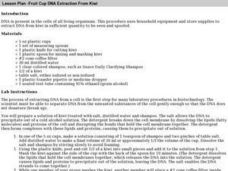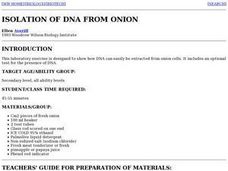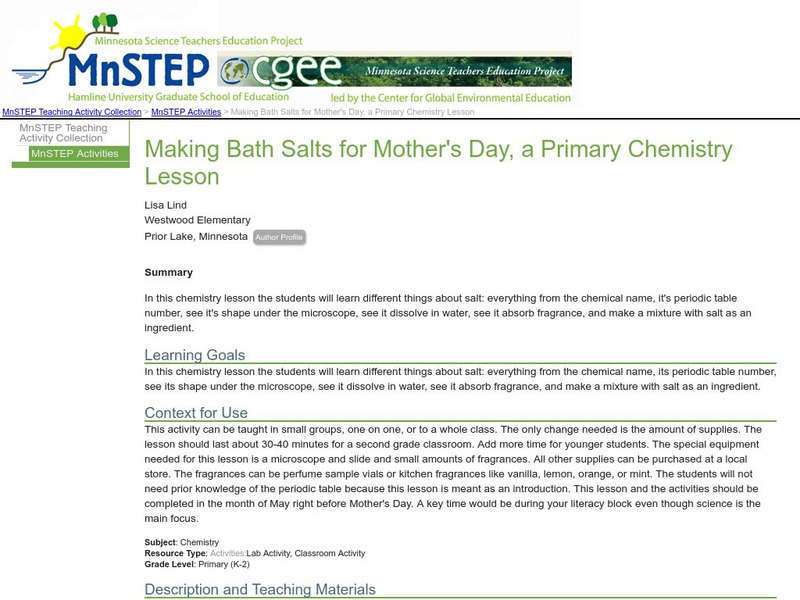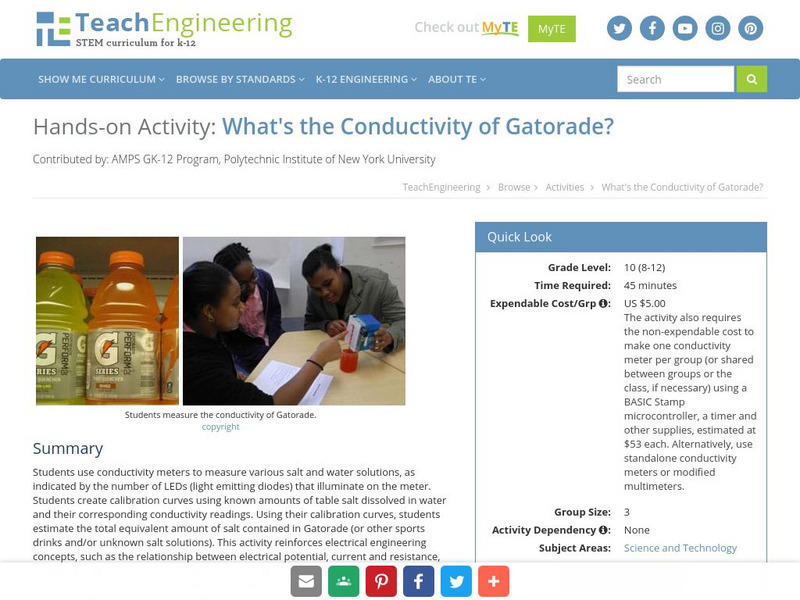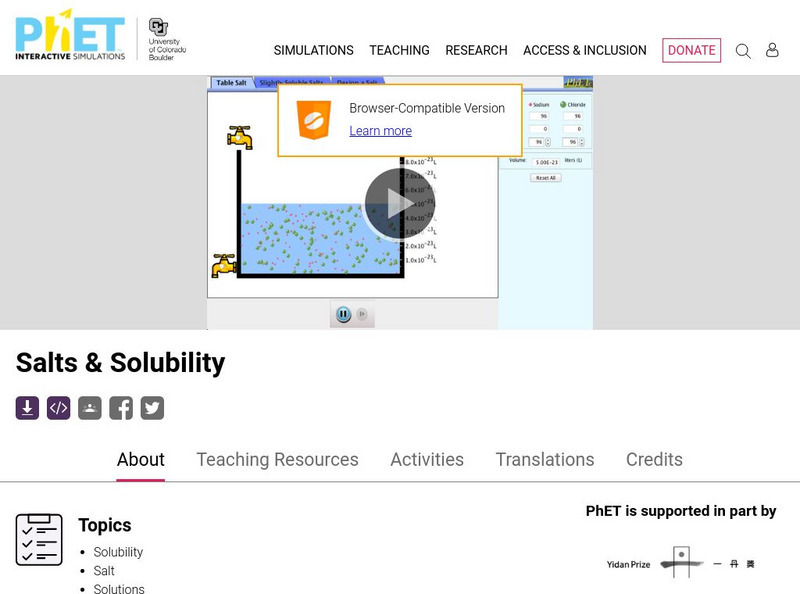Curated OER
DNA Extraction From Onion
Students extract DNA from an onion using household equipment and supplies.
Exploratorium
Penny Battery
Use pennies to light an LED. Class members follow the provided directions to build a multi-celled battery powered by pennies. Using stacks of pennies of varying heights, pupils control the voltage of the battery to light different colors...
Curated OER
Solutions
Amateur chemists define and describe properties of solutions, compare solubilities, explain how solutes affect freezing and boiling points, describe acid and base properties, and more! This educational PowerPoint provides information and...
Curated OER
Fruit Cup DNA Extraction From Kiwi
Learners extract DNA from kiwi using household equipment and supplies.
Curated OER
Making Paint
Students discover how paint is made, then create their own paint which they will use to create a picture. After witnessing the processes of emulsion and suspension, students work in groups to create their own paint, and then create...
Curated OER
More on Temperature and Solubility
Learners discover how temperature effects the solubility of solutes by experimenting with a range of temperatures. They develop skills for observing, inferring, measuring, comparing and contrasting.
Curated OER
Earth Systems
Ninth graders investigate biological systems. They summarize relationships between systems. Students determine how systems relate within the biosphere. They analyze the carbon cycle.
Curated OER
Worksheet 6: Reading: Recipe for Beignets
Travel to New Orleans for their warm, sweet beignets, or bring a piece of New Orleans to your classroom by baking the delicious treats with your third and fourth graders! If baking them isn't possible, at least review the recipe for a...
Curated OER
Kitchen Electrophoresis
Students investigate and explain the differences active transport versus passive transport. This instructional activity includes an individual and group activity. The basic steps of electrophores is the focus of inquiry. Identification...
Curated OER
Yellow Pod
Students use appropriate skills to design and conduct scientific investigation. They sort and classify various ingredients and analyze their investigation. Finally, students describe the observable states of matter, bot solids and liquids.
Curated OER
ISOLATION OF DNA FROM ONION
Students perform a laboratory exercise designed to show how DNA can easily be extracted from onion cells. They conduct an optional test for the presence of DNA using standard lab equipment.
Curated OER
DNA: What Does It Mean?
Tenth graders explore DNA using online tutorial. They perform their own DNA extraction from a clove of garlic and identify the key components of DNA.
Curated OER
DNA Isolation
Students use scientific methods to investigate the concept of DNA. They observe the DNA of human cheek cells. This is done with the use of a lab experience. Students record their observations and reflect upon on how each organism is...
Curated OER
Rusting: A Form of Oxidation
Students observe and record the corrosive nature of oxidation-reduction reactions, and determine the electro-chemical series of selected metals.
Curated OER
Enzymatic Reaction
Students explore the effect enzymes have on reactions. They demonstrate the process of enzymatic reaction by making cheese. after experimentation, they answer a series of questions.
Curated OER
Milk and Dairy Test
Students explore how to select and prepare milk and milk products, identify standard serving size for milk and milk products, review terms associated with milk and milk products, and demonstrate knowledge of how to use and care for these...
Utah STEM Foundation
Utah Stem Action Center: Salt Dissolved in Great Salt Lake
In this activity, students will compare water from a fresh lake to water from the Great Salt Lake to begin to build a conceptual model for how salt dissolves in water. The activity focuses on students using and developing models of...
Concord Consortium
Concord Consortium: Molecular Workbench: Dissolving Salt in Water
View this simulation to see salt dissolve in water at the molecular level.
American Chemical Society
Middle School Chemistry: Lesson Plans: Why Does Water Dissolve Salt?
Students use their own model of a salt crystal and water molecule to show how water dissolves salt. Then, they relate their observations to the structure of salt, water, and alcohol on the molecular level.
University of Colorado
University of Colorado: Ph Et Interactive Simulations: Sugar and Salt Solutions
What happens when sugar and salt are added to water? Pour in sugar, shake in salt, and evaporate water to see the effects on concentration and conductivity. Zoom in to see how different sugar and salt compounds dissolve. Zoom in again to...
Science Education Resource Center at Carleton College
Serc: Making Bath Salts for Mother's Day, a Primary Chemistry Lesson
What do you know about salt? For this chemistry lesson, students will learn different things about salt: the chemical name, it's periodic table number, it's shape under the microscope, how it dissolves in water, and how to make a mixture...
TeachEngineering
Teach Engineering: What's the Conductivity of Gatorade?
Students use conductivity meters to measure various salt and water solutions, as indicated by the number of LEDs (light emitting diodes) that illuminate on the meter. Students create calibration curves using known amounts of table salt...
ClassFlow
Class Flow: Dissolving and Evaporation
[Free Registration/Login Required] Ever wondered what happens at the molecular/ionic level when salt is dissolved in water or salt-water is evaporated by heating/boiling? Peek into the molecular world with this flipchart to view these...
University of Colorado
University of Colorado: Ph Et Interactive Simulations: Salts and Solubility
Add different salts to water, then watch them dissolve and achieve a dynamic equilibrium with solid precipitate. Compare the number of ions in solution for highly soluble NaCl to other slightly soluble salts. Relate the charges on ions...





